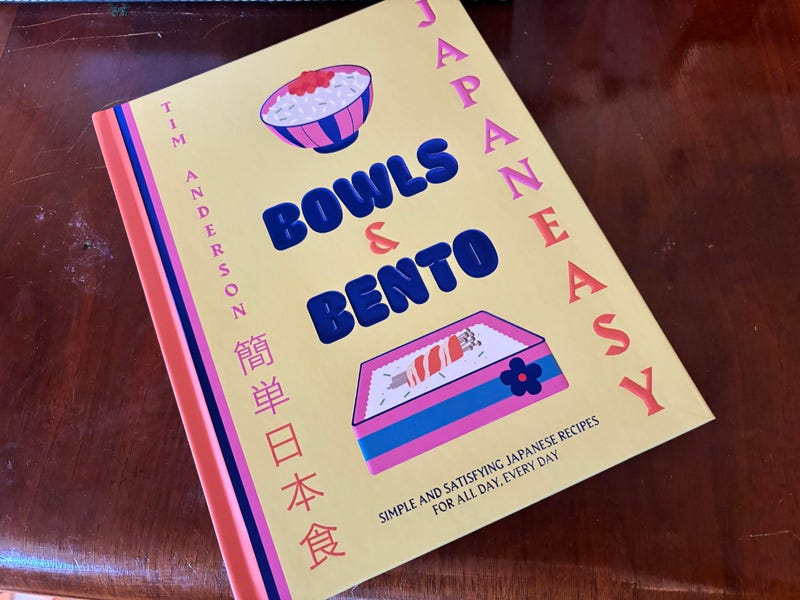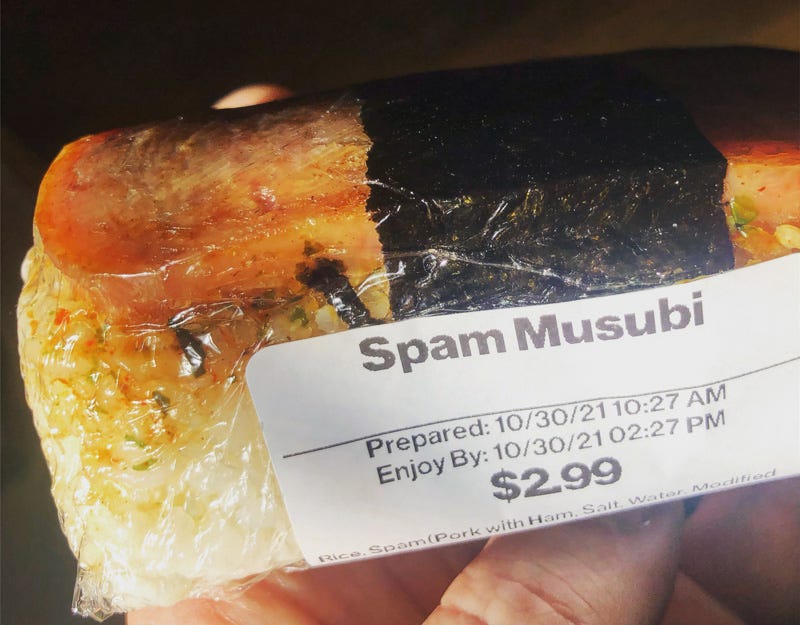THE COOKBOOK TEST #0025: JAPANEASY BOWLS & BENTO: PART ONE
INSTALLMENT #0025 (PAID) WHY DOES HOME TASTE LIKE NORI AND WASABI? / THE DUALITY OF SPAM / SPAM MUSUBI / TORI-JIRU
Dear Subscribers,
Every now and again a book really, really strikes a chord for me. JAPANEASY BOWLS & BENTO, by Tim Anderson, is one of those books. The writing is clean and accessible, the recipes are cleverly and briefly introduced, pitched, explained, and contextualized. The recipes aren’t all simple, but they don’t feel precious or overly complicated; unlike the (also delightful) JAPAN: THE VEGETARIAN COOKBOOK, there’s nothing about Japaneasy that feels like being beaten by a really strict but sincere Shinto priest wielding a lovingly hand-wrought iron soup paddle. This book is loaded with recipes that connect with Japanese traditions and ingredients but with an eye toward usability and modern life, up to and including a few that rely upon the *sharp intake of breath* microwave.
For reasons that may remain elusive from me for the rest of my years, Japanese food tastes like “home” to me. My parents never served it, nor did they take us to Japanese restaurants; I never tried anything even vaguely Japanese until traveling to the Yaohan mall in Chicago as part of a field trip for my high school Japanese language class. At Yaohan, I tried a variety of sushi rolls (which, as far as I can parse from 30 years later, were neither particularly bad nor particularly good). The impact of seasoned sushi rice (totally new to me), raw fish (likewise), and seaweed (likewise) was like, as Col. Walter Kurtz so thoughtfully put it, like taking a diamond bullet right to the forehead. I didn’t have the vocabulary for what I’d tasted, but a week later I was craving it, viscerally, and I’ve been eating it (and making it at home) ever since.
Alright, here it is, maybe - I was 17 or 18 years old, taking a new language, tasting a completely new food, making (lifelong) friends who were my match emotionally and intellectually, and ready to stretch my wings and get out into the world. I was, after years of being a kid, becoming me - and Japanese-American food is something that I fell in love with at the precise moment I was carving that identity.
So, somehow, a book like Japaneasy is a way back to the beginning. Not before things went bad, because things have actually mostly gone pretty well, but before things got grown-up, and serious, and partially or mostly determined. That’s some seriously comforting stuff - the feeling of having all of one’s life ahead of oneself, roads all ready to unroll and be explored, milestones ready to be reached and journaled. But! Viewed from the comfort of middle age, when I can mostly look back and say, “Yeah, that was a pretty decent road ultimately, wasn’t it?” The best of both worlds, on a plate. Or in a bowl. Or in a bento box.
at your service,
James
JAPANEASY BOWLS & BENTO
BY TIM ANDERSON
HARDIE GRANT BOOKS | 2022 | $35
There was one particular moment while reading Japaneasy that the lightbulb went on, and I thought, “Oh, damn, author Tim Anderson is MY KINDA DUDE.” It wasn’t when I caught the bit in his biography about being born in Wisconsin and then living in Japan and then England (a place I was also born, a place I have thought constantly about visiting forever, and a place I would’ve studied abroad in college had I not been elected editor of my college newspaper, respectively.) That sort of got the light warmed up and ready to go. But the magic moment was the author’s introductory paragraph about SPAM Musubi, a dish close to my heart that I make at home several times a year when I’m too tired to go shopping but too passionate to just eat random crap out of the freezer or pantry.
Spam is a tricky one. On the one hand, I love it, and it is a legitimate part of Japanese gastronomy - specifically in Okinawa, and among the Japanese diaspora of Hawaii. On the other hand, it’s ethically and nutritionally questionable (to say the least), and it only came to be adopted into Japanese cooking via the American military-industrial complex. Is Spam a delicious, convenient, perfectly legitimate and beloved Japanese ingredient, or is it just a salty, fatty, unpleasant pink lump of colonial jetsam? Could it be both? F. Scott Fitzgerald said, ‘The test of a first-rate intelligence is the ability to hold two opposing ideas in mind at the same time and still retain the ability to function.’ You look like you’re of first-rate intelligence. Here’s a Spam recipe!
Ever since I got into SPAM musubi some years ago (thanks to trying it at the deli of the nearby United Noodles in Minneapolis - see below) I have wrestled with exactly this sort of thing: It’s legitimate! It’s authentic! It’s connected to Minnesota (where I live) and Japan (which I love in abstract!) And it’s trashy! It’s cheap (in a bad way)! Ultimately, however, I have come down on it as follows: It’s cheap (in a good way) and it’s delicious, so it’s sticking around, as will SPAM fried rice. So I deeply appreciate the author’s ambiguous feelings about the stuff, and his ability to so elegantly and quickly wrestle with them on the page.
Having said all, here’s a SPAM musubi recipe (my own) that hasn’t failed me yet:
SPAM MUSUBI
Get a can of SPAM, remove the SPAM, and slice it into 1/4” slices. Sear the slices in a sauté pan until browned on both sides, and then finish with a mixture of 2 Tbsp brown sugar and 2 Tbsp of soy sauce, which after a couple minutes will thicken up and coat the SPAM. Remove the SPAM from the pan and set aside.
Stuff plastic wrap into the empty can of spam. Insert a thick strip of nori that will act like a belt to hold the SPAM onto your block of rice.
Smoosh a lacquered SPAM piece into the bottom of the can (it fits perfectly! hooray!), and sprinkle it with sesame seeds and/or furakake. Then smoosh warm sushi rice into the can, about an inch thick. Wrap with nori (trim if necessary to make a neat little parcel) and serve.
SUSHI RICE
Alright, I guess we’re kind of begging for a sushi rice recipe here. Here’s what I’ve been working with. The number one insight? Don’t over-dress it. And yes, buy a rice cooker if you don’t own one. Absolutely, positively, one of the best and most worthwhile unitaskers in the kitchen. (Not even a unitasker if you use it to steam buns or cook other things with your rice, which you can.)
SUSHI RICE
Put 2 cups of sushi rice with water (to marked level) into a rice cooker, and add a 2” square of kombu seaweed. Fire that sucker up.
Meanwhile: bring to a boil while stirring 1/4 Cup of rice vinegar (or 3 Tbsp white vinegar), 3 1/2 Tbsp sugar, 2 1/2 tsp salt, and 1 1/2 Tbsp mirin. Make sure the sugar and salt dissolve fully. Let this dressing cool.
When the rice is finished, put it into a large bowl. While hot, stir in a bit less than half of the dressing while fanning the rice and stirring it for a few minutes, until the dressing is incorporated. The rice should be moist but not soggy or pooling dressing at the bottom. If it can take a bit more dressing, add it and keep fanning. You’re unlikely to use more than 75% of the dressing in any circumstances.
Fanning the rice is important! It took me like two years and a sushi-making class before I realized how much it really helps the rice absorb the dressing evenly.
CHICKEN, ROOT VEGETABLE, AND PEARL BARLEY SOUP
I was drawn to this recipe (also known as Tori-Jiru) due to its pure comfort factor - quite a lot of chicken and broth, homey root veg and a lot of miso, and the chewy goodness of pearl barley, an ingredient than I am always, always, always happy to encounter for its mellow affability and textural entertainment factor.
It’s not a complicated soup. This is a soup that requires about an hour of hanging out in your kitchen, listening to music, chopping things up and leisurely dumping them into some hot liquid to cook. The original recipe was small (serves about two) and has some flex between hard-to-find and easy-to-find ingredients, so my simplified version below doubles the quantities (and goes even harder on the chicken front) and errs on the side of “available at your local grocery store.”
There’s nothing otherworldly about this soup, but it’s soothing as hell and nourishing and pleasant. The surprisingly large chunk of miso that hits at the end of the make really builds a big broth, and the variety of vegetables plus barley makes it texturally delightful. Based on the photography, red miso is probably the way to go for authenticity’s sake, but I had white miso in my fridge and since the recipe didn’t specify, I took the lazy man’s way out. My 10-year-old, who really loves miso soup, thought it was OK; my 5-year-old, who dislikes most things, loved the hell out of it and requested a second bowl. There’s something here. This stuff is good.
CHICKEN, ROOT VEGETABLE AND PEARL BARLEY MISO SOUP
Serves 8 as a starter or side, or 4 as a main
½ cup pearl barley, cooked - simmer for 20-30 minutes in 1 ½ cups chicken stock until tender but still chewy, rinse in cold water and drain
3 chicken thighs, boned and cut into .75” chunks
1 onion, diced
2 garlic cloves, finely chopped
10 g (½ oz.) fresh ginger root, peeled and shredded
5 cups dashi or chicken stock
4 oz. radishes, washed and quartered
5 oz. parsnips, peeled and cut into ½” cubes
1 medium carrot, peeled and cut into ¼” thick semi circles
4 oz. miso
3 scallions, finely sliced
Place chicken, onion, garlic, and ginger into the chicken stock and bring to a simmer in a pot for about 15 minutes. Add radishes, parsnips, and carrots, and cook another 15 minutes until vegetables are soft. Top up pot with water if you lose more than a half inch or so - just replace what’s been lost.
Add the cooked barley, simmer for a few minutes, whisk in the miso and spring onion and remove from heat.
NEXT WEEK: MORE FROM JAPANEASY BOWLS & BENTO! That’s right, I need to cook more from this book because it rules, and I think there’s more to be said about it. After that, we’ll flying off in some other (probably vintage) direction entirely. Maybe something summery, because at the current rate of warming, it’ll be in the mid-80s in Minnesota by early March.





